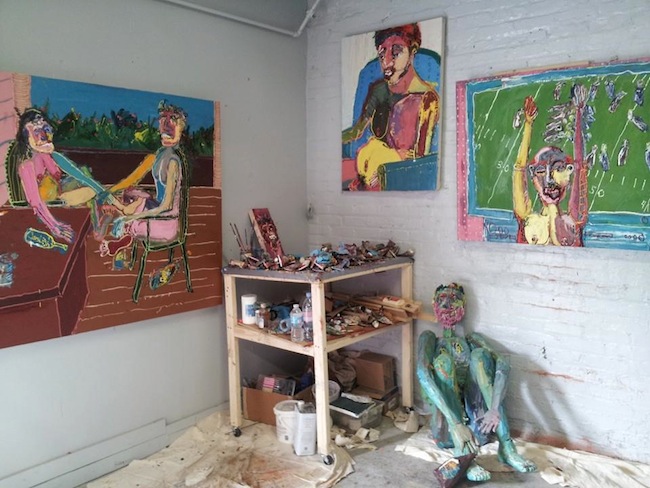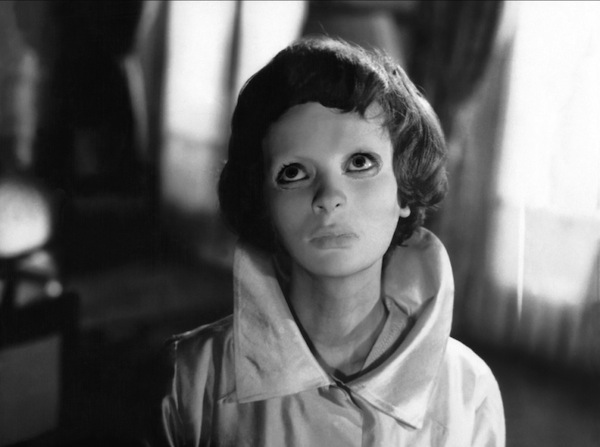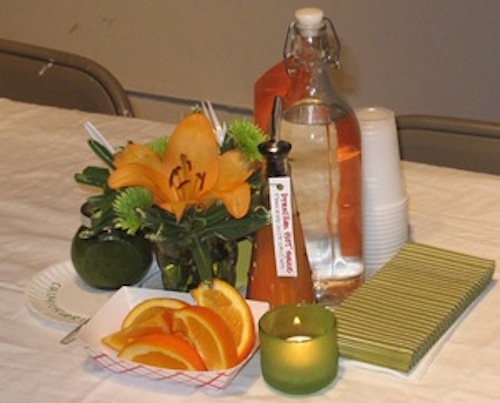Twice a month, Kim Farmer hosts supper and a film screening in the gallery at Area 405 with her husband and co-host, Mark Mordhorst. These evening events are installations of the ongoing Cinema Series 405: curated gatherings designed to engage film enthusiasts and foodies alike by providing a forum for film discussion following a stimulating meal. The unique pairing of food with film is thoughtfully conceptualized and executed by Kim Farmer, each menu item complementing and highlighting carefully examined elements of the film shown. Although the events are BYOB, her co-host crafts themed cocktails for an additional, likely worthwhile, cost. (After all, what could be more satisfying than a triptych of perfectly paired imbibements, food, and entertainment?) The hosts can accommodate up to 30 guests per screening, so take reservations for these evenings in advance.
This season, the hosts selected the theme of “obsession” to riff on, and chose five films that exemplify this theme to screen from September through November. As they state on the Area 405 website, obsession is a multidimensional and complex theme oft-visited by filmmakers, taking forms as diverse (or as similar) as lust and revenge. With films ranging from 1959 (Georges Franju’s Eyes Without A Face) to 1982 (Werner Herzog’s Fitzcarraldo, Martin Scorcese’s King of Comedy), I wanted to ask Kim Farmer for more details about the thematic selection process, her creatively-inspired menus, and the mechanics of hosting an engaging evening with Cinema Series 405.
A-B Moore (AB): Does the Fall 2013 film series correlate or corroborate with any shows that will be concurrently hanging in the gallery at Area 405?
Kim Farmer (KF): With past series – I attempted to tie in films to concurrent exhibits or events – in spite of my cohort’s dislike of this approach. I’ll let him – my husband, Mark Mordhorst, explain his objection.
Mark Mordhorst (MM): I don’t object to relating the film selections to the exhibits if it makes sense to do so. We have had moments in that effort where I thought it seemed forced and didn’t make much sense, especially when a film series has its own theme. I like to think of our series as exhibits of their own that we select carefully, not just a tie-in to whatever hangs in the gallery.
KF: Yes, well, some of my associations, I’ll admit, have been more successful than others and frankly I’m not sure how much our audience cares about having the art on exhibit connect with the film.
With the Winter series, I chose two films from 2003 that are strongly and particularly collaborative to correspond with 405’s “Sweet ‘Art” exhibit, a collaboration-themed show that also celebrated 405’s 10th anniversary. All films are joint efforts, of course, but in the case of Korea’s Spring, Summer, Fall, Winter…and Spring, director Ki-duk Kim’s story relies heavily on Dong-hyeon Baek’s cinematography, while Scandinavia’s Kitchen Stories, told the story of an unusual and inevitable friendship between a Swede and a Norwegian from a script written by Swede Jörgen Bergmark and Norwegian Bent Hamer (who also directed).
With our first film this past Spring, On Loan: Formality was up, and so I selected Hiroshima, Mon Amour – a highly structured film that relies heavily on filmic elements to tell it’s story (flashback, montage, repetition, soundtrack), and one that also supported my theme for the series “A Woman is a Woman” (borrowing a title from a Godard film which I did not show. It is a title I find both gloriously meaningless and meaningful.)
I also endeavored to connect the last two movies of that series – Joseph Losey’s Eva and John Huston’s Reflections in a Golden Eye with the Baltimore Performance Kitchen’s production of Romeo and Juliet at 405. Admittedly, the correlation’s were weak – Eva is set in Italy and has elements of tragic love – and Reflections is tragic and concerns unattainable love.
Mark took the lead in programming the current series, and, as I said, is not a fan of corroborating the film choices with 405 events. But, I was delighted when the first film, Lolita, (inadvertently) resonated – if obliquely – with the concurrent exhibit “Knowing” (subtitled “Having tasted knowledge, we grew naked”) – where the question was raised “Was Adam’s Eve a victim or a temptress?”, a query that certainly comes to mind when contemplating Stanley Kubrick’s depiction of the character Lolita.
The next two selections – Cape Fear and Eyes without a Face are obsession-themed but also offer the suspense and discomfort audiences crave in October leading up to Halloween. No exhibits are planned for October, but the Dan Meyer Choir will be at 405 on October 27th for a “spooky” concert.
AB: Why did you pick the theme of “obsession”? In what thematic direction is Cinema Series 405 heading in 2014?
KF: Mark chose this theme, primarily, I think because he really wanted to show Herzog’s Fitzcaraldo. We had hoped to also show something Japanese, but feared that their best examples of obsession are too racy (In the Realm of the Senses) or too abstract (Japanese Summer: Double Suicide).
As for the future, we are talking with Linda DeLibero – film critic for WYPR and Director of JHU’s Film and Media Studies- about curating an upcoming program.
AB: How did you interpret this theme of “obsession” to select the movies for this film series?
MM: Obsession is a classic dramatic trope and some of the best films are about obsession or obsessive characters. Much dramatic tension is wrought from obsession. It’s true that the choice was largely driven by my fondness for Herzog’s films because if any one does obsession well, it’s Herzog. What I realized when I decided on the theme of obsession is that the majority of films on obsession are about romantic or sexual obsession. I did not want it to be exclusively about that and thus I thought of Fitzcarraldo. We tried to select a balance of films on obsession without seeming too sex-obsessed ourselves. So, my interpretation of obsession is in the broader sense of obsessive personalities and how they propel stories and appeal to the obsessive nature of all of us.
AB: Looking back at past film series, the menus are each incredibly unique- and creatively obscure. How do you conceptualize the menu to accompany each film?
KF: I always try to find something in the film that I can reference or riff on. If anything edible appears – whether or not characters are shown eating it – I want it on the menu, i.e. Cape Fear = Eggs, and Lolita = Cherry Pie. I’m not sure the audience always notices, but it amuses me. Otherwise, I look to the setting for inspiration.
AB: To me, adding a creatively-designed supper to a film screening at an artist-operated gallery and studio space gives this event the context of a collectively executed, community-engaging act of performance art. Why add supper to a film screening? What is Area 405’s goal in hosting these events, and how do artists at Area 405 participate?
KF: A few years ago, we were having dinner with our friends Stewart Watson and Jim Vose – two of 405’s owners – and they asked us if we had any ideas for new ways to use the space. We thought on it for awhile and being long-time cinephiles we pitched our movie night. At this time had no plans for serving a meal. As the start of the first series approached, it occurred to me how hard it can be to squeeze in a proper meal before going out to a movie – especially on a weeknight – since we started out on Thursday nights – and so we decided to add supper. I purposely used the word “supper” to indicate a simple, homey repast. In previous lives I was a caterer and professional cook, so cooking for 30 is not too daunting. However, I do have to be savvy about what I serve as 405 does not have a kitchen.
Our goal along with 405’s owner is simply to offer a pleasant and stimulating experience for the public – a community service really – hence the low price. I am sorry to say that the artists with studios at 405 have shown little interest if any in our event. A few artists who have shown at 405 do come, as well as some artists we know from outside 405. I have been assisting with exhibits at Area 405 since last February (4 exhibits totaling approximately 120 artists) and I don’t think one of them has attended a film night. I don’t know why this is.
AB: What’s the turnout like for these events?
KF: Attendance has been steadily increasing as word gets out, and we do have several regulars. We put a cap of 30 people on it, since that’s all the comfortable seating we have for movie watching, and 30 is not too difficult to cook for. Seems like we average about 24 – we’ve only sold out once or twice. I think we ended up with 33 people for The Little Foxes last spring.
We do tend to attract an older crowd – often creative types and academics – and it is the older people who appear more game for the post-film discussion. Last series, I was lamenting to the 20-year-old intern the fact that we were not attracting a more diverse audience – a better mix including 20 and 30 somethings. His response was “Well, you show old movies.” The other intern at the time requested that we show “Kill Bill.”
As a film fan, I certainly appreciate Tarantino’s talent and the hyper stylization of Kill Bill, and more contemporary choices are not off limits. It’s just that so far, we’ve been drawn to showing movies that merit a re-visit or examining ones we missed the first time around and/or introducing some film history to folks who are new to it. Clearly not every artist digs film or film history.
We’ve had some people come and never return, but by and large people do return. There are lots of movie nights around town, but I think we are the only ones to include a meal. It’s quite nice really, to arrive and indulge in one of Mark’s thematic cocktails and then wander around a bit to look at the art, then sit down and break bread with old friends and/or new friends. Even when there is not an exhibit up, Area 405 is such a great place to just hang out in.
For more information on Cinema Series 405, visit http://area405.com/cinema-series-405/
For the Fall 2013 lineup and to make reservations, visit http://area405.com/fall-2013/
Trailers for Upcoming Films at Area 405:
10/25: Eyes Without A Face (1959)
11/8: Fitzacarraldo (1982)
11/22: King of Comedy (1982)
* Author A-B Moore is a Baltimore-based multimedia artist and illustrator from North Carolina. She received her BFA in painting at the Maryland Institute College of Art in 2013, but in practice explores interdisciplinary methods involving found objects, ceramics, drawing, watercolor, and text.










